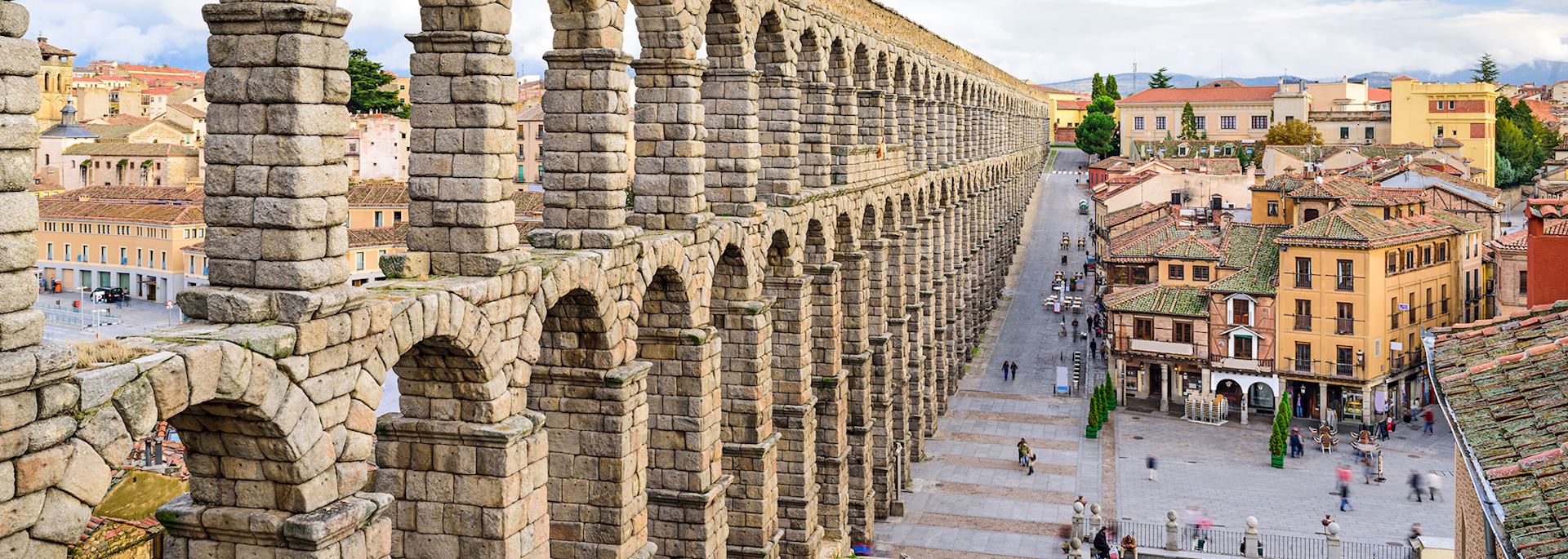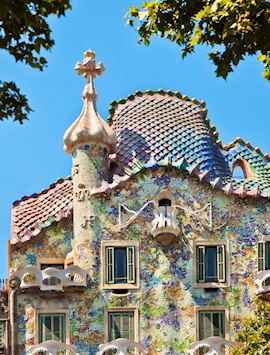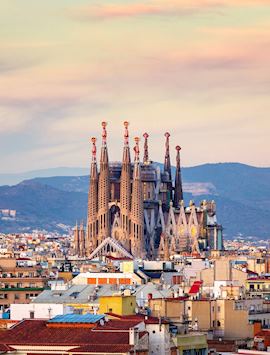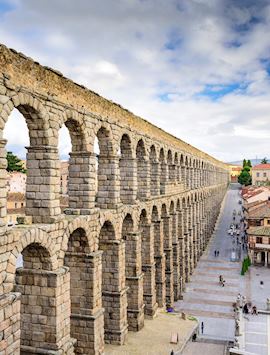Jump to:
Seat of Castilian royalty, trading place for the Moors and a symbol of ancient Rome’s expansion — Segovia can draw a thick line through its history back more than two millennia.
An 11th-century Alcázar (fortress) that resembles a Bavarian castle is Segovia’s crowning glory. But, even without its presence, Segovia could still boast a Roman aqueduct that serves as an entranceway to the old town and Spain’s final great Gothic achievement, a 16th-century cathedral. It stands close to the Alcázar at the head of a promontory, bound by city walls that date partly to medieval times.
Rising from the rock at the point where the outcrop falls away, the Alcázar (palace) wouldn’t look amiss in a Grimms' Fairy Tales illustration. It’s the latest incarnation of a fortification that has held the position since the Roman occupation. The current rendering is relatively new-built, a restoration of the medieval version that burned down in the mid-1800s. A multi-sized assortment of slate-roofed turrets point into the air like fireworks and give the Alcázar a distinctly Bavarian air.
In its time, the Alcázar has served as a fortress, a palace for the Castilian monarchy, a prison and the Royal College of Artillery. Touring it, you can visit the palace rooms and the Artillery Museum. For a small extra ticket cost, you can also climb the 152 steps of a spiral staircase to reach the top of the Torre de Juan II (the Tower of Juan II). A hulking cuboid, it’s the palace’s tallest tower and a vantage point from where you can survey the city and surrounding countryside as it runs toward the Sierra de Guadarrama mountain range.
Segovia’s Roman aqueduct endures as one of the great statements of ancient Rome’s triumphal expansion across Europe. But, unlike many of the continent’s other surviving aqueducts, it has become part of the fabric of a city. It runs like a gateway across the thoroughfare that winds its way up into Segovia’s old town, and more likely than not you’ll cross under it at the start of your visit.
The aqueduct supplied the city with water into the 20th century. Rising to a double tier of arches, 28 m (92 ft) at its highest point, it sits on 6 m (92 ft) deep foundations. The long-limbed pillars of the lower arches are 3 m (10 ft) wide at their base, and at close quarters you can wonder at the precision building of the granite blocks and the lack of mortar required to shore up the whole thing.
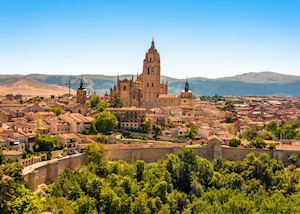 Dominated by its tower and notable for its plentiful chapels (numbering more than 20), Segovia’s cathedral marks the swansong of Spain’s age of Gothic cathedral building. Inside, you can see stained-glass windows preserved from the 1300s, and the assorted paintings and sculptures of the chapels as well as a collection of religious artwork in the cathedral’s museum. For elevated views of the city you can climb the bell tower, where a toller lived up until the mid-1900s.
Dominated by its tower and notable for its plentiful chapels (numbering more than 20), Segovia’s cathedral marks the swansong of Spain’s age of Gothic cathedral building. Inside, you can see stained-glass windows preserved from the 1300s, and the assorted paintings and sculptures of the chapels as well as a collection of religious artwork in the cathedral’s museum. For elevated views of the city you can climb the bell tower, where a toller lived up until the mid-1900s.
The city’s signature dish is cochinillo asado — suckling pig that’s been seasoned with just salt and pepper and then roasted in a special oven until the flesh is meltingly tender, the crackling skin crisped until it shatters into golden-brown shards at the touch of a fork. It’s a traditional dish and the rules surrounding its production are strictly enforced — only milk-fed piglets of a specific breed may be used and the nursing sows must be fed a special diet.
Segovia’s fondness for the dish is immediately apparent — statues of pigs and piglets are everywhere around the city and many of the restaurants serve their own version. However, the godfather of cochinillo asado is José María Ruiz Benito and his restaurant, Mesón de José María, serves what might be the definitive version. No matter where you choose to eat, cochinillo asado makes for a leisurely mid-day meal, one to be lingered over with a glass of wine. The pig must roast for several hours, so reservations are vital — we can book a table for you before you leave.
Another local delicacy to try is ponche Segoviano, an alcohol-soaked (typically, sweet wine) layer cake cushioned with custard and encased in marzipan. Decorative patterns are often branded onto the top. Visit one of the city’s pastelerías (cake shops) to buy a piece of this little-known confection of which Segovians are rightly proud.
White storks take advantage of Segovia’s towers and tall trees for nest building (they’re proactively welcomed as a sign of good things to come). You’ll see them sitting on their nests and hear the otherwise mute birds as they tilt back their long necks to rattle their bills. With a wingspan about 2 m (6.5 ft) wide, their presence in the sky is hard to miss as they glide overhead and home in to land on their nests.
Together with Toledo and Ávila, Segovia is one of the ring of historic cities that lie within an hour’s drive from Madrid.
Best time to visit Segovia
Temperatures in Segovia start to rise to comfort levels around March time. May and June are particularly good times to visit, at a point in the year when the city has warmed up but isn’t under the cloying heat of high summer. The heat continues to ramp up until August, when it can be stifling with peak temperatures above 30°C (85°F). September marks the turning point of the year, when the mercury drops to make it a pleasant time to visit through until the end of October. Segovia’s winter months normally keep bright skies but are chilly and require you to warm up in the day and evening.
who's been there
-
01993 838 92501993 838 081
- Make an enquiry
Suggested itineraries featuring Segovia
Our itineraries will give you suggestions for what is possible when you travel in Segovia, and they showcase routes we know work particularly well. Treat them as inspiration, because your trip will be created uniquely by one of our specialists.
Places near Segovia
- El Escorial & Valle de los Caídos 25 miles away
- Ávila 37 miles away
- Madrid 43 miles away
- Toledo 76 miles away
- Salamanca 81 miles away
- La Rioja 135 miles away
- Bilbao 172 miles away
- The Basque Country and La Rioja 174 miles away
- Asturias 188 miles away
- Oviedo 189 miles away
- San Sebastián 198 miles away
- Córdoba 215 miles away
- Galicia 232 miles away
- Pontevedra 255 miles away
- Granada 262 miles away
- Santiago de Compostela 264 miles away
- Andalusia 266 miles away
- Seville 266 miles away
- A Coruña 276 miles away
- Costa del Sol 294 miles away
- Ronda 296 miles away
- Catalonia 297 miles away

